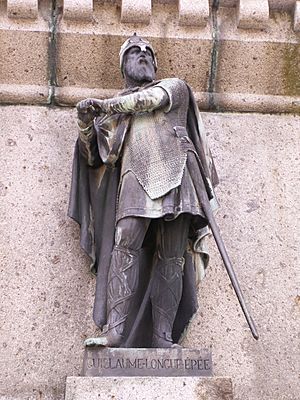William I, Duke of Normandy facts for kids
William I Longsword (around 900–942) was an important leader. He was the second "Duke of Normandy," following his father, Rollo. William made his family's lands bigger. He also started to spread Norman power in what is now France.
Contents
Who was William Longsword?
William was born to the Viking leader Rollo and his Christian wife, Poppa of Bayeux. He was likely born outside of Normandy, possibly in England. His mother came from a powerful Frankish family. William became a Christian through Baptism, probably at the same time as his father.
William's nickname, "Longsword," likely came from battles he fought. These fights happened between 924 and 925 around places like Beauvais, Ponthieu, and Amiens.
Becoming Duke of Normandy
William took over as leader after his father, Rollo, in 927. Early in his rule, he faced a rebellion. Other Normans did not think he was a good leader. Riouf of Évreux led this uprising. Around this time, William sent his wife, Sprota, to Fécamp. Their son, Richard, was born there.
Expanding Norman Lands
In 933, William I Longsword promised his loyalty to Raoul, who was the King of Western Francia (France). In return, King Raoul gave William control over many lands that belonged to the Bretons. These lands included Avranches and the Cotentin Peninsula.
However, the Bretons fought to keep their lands. They were led by Alan II, Duke of Brittany and Count Berenger of Rennes. The fighting ended when Alan fled to England. Count Berenger then tried to make peace with the Normans.
In 935, William arranged a marriage for his sister, Adela. She married William, Count of Poitou. This marriage was approved by a powerful noble named Hugh the Great. At the same time, William married Luitgarde. She was the daughter of Herbert II, Count of Vermandois. Her dowry (money or property brought by a bride to her husband) gave William lands like Longueville, Coudres, and Illiers l'Eveque.
Conflicts and Death
William Longsword attacked Flanders in 939. Because of this, Arnulf I, Count of Flanders, and Louis IV, King of France, attacked Normandy. Arnulf captured the castle of Montreuil-sur-Mer. He defeated Herluin, who was the Count of Ponthieu. Herluin then helped William Longsword take back the castle.
William was excommunicated (removed from the Christian church) for attacking and destroying Arnulf's lands. William promised his loyalty to King Louis IV when they met in 940. In return, King Louis confirmed that William controlled the lands given to his father, Rollo.
Almost three years later, on December 17, 942, William Longsword was killed. This happened at Picquigny on the Somme River. He was at a peace meeting to settle his disagreements with Arnulf. Followers of Arnulf attacked and killed him.
William's Family
William had one son with Sprota:
- Richard the Fearless, who became Duke after his father.
William later married Luitgarde, daughter of Herbert II, Count of Vermandois. They did not have any children together.
See also
 In Spanish: Guillermo I de Normandía para niños
In Spanish: Guillermo I de Normandía para niños


